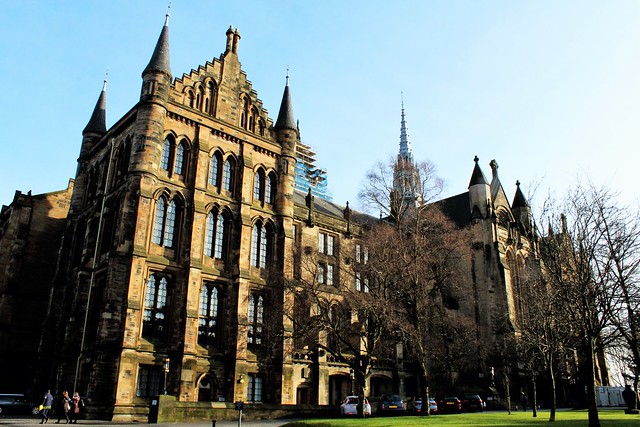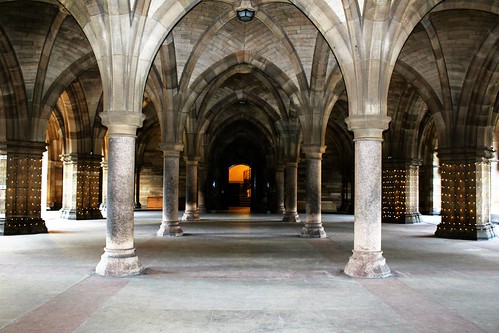Glasgow University, a venerable academic institution founded in 1451
This evening, I am providing information on Glasgow University. Summary information as follows:
- Founded 1451 on order of Pope Nicholas following an initiative by King James II (Scotland) and Bishop William Turnbull.First classes were held in Glasgow Cathedral until relocation to purpose-built building in High Street in 1460 where it remained for the next four centuries. A new building was constructed on what was a greenfield site in Glasgow’s West End to where the institution relocated in 1870 and has remained ever since.
- Student role is over 24,000. The university is second oldest in Scotland and fourth oldest in U.K.
- The heart of the University is known as the ‘Gilbert Scott Building’ as consequence of its design by Sir George Gilbert Scott ( 1811-1878), in neo-Gothic style. Scott’s son, George Gilbert Scott ( 1839-1897) redesigned the university’s tower whilst the latter’s son, Giles Gilbert Scott ( 1880-1960) designed the classic British red telephone booth examples of which can be found on campus.
- The stone is mixed colouration because some was freshly quarried local sandstone whilst other masonry, darkly stained with pollution, was recycled from the old buildings in High Street.
- The buildings in ‘Professor Square’ were formerly residence occupied by academics. However, most are now used as offices. One of the houses was occupied ( 1870-1899) by William Thomson, Baron Kelvin of Largs, a notable physicist who gave his name to the kelvin temperature scale and was involved in the transatlantic telegraph cable.His property was the first house in Europe to be fully powered by electricity.
- The Principal’s House is of some substance, sitting on edge of Professor Square.
- The Glasgow University Chapel is used for inter-faith worship. Work commenced 1913 but halted due to WW1. Work re-started in 1923. 755 students and staff died during WW1.The Chapel is dedicated as a War Memorial.
- The Lion and Unicorn Staircase dates from 1690s and was relocated from the former High Street building.It formerly provided access to the main teaching hall. It is now of symbolic relevance and used for graduation ceremonies. Einstein posed here for his honorary degree in 1933.
- The front facade of the building contains places for statues which have never been occupied. This was a device used by Scott to ‘age’ the building. Many old abbeys and similar buildings in Scotland had their statues removed at the Reformation in 1560 leaving voids which are evident today.
- The tower was intended by Sir George Gilbert Scott to be made of wood but his son re-designed in stone, incorporating a bell instead of a clock.
- Final part of the main building, Bute Hall, was funded by the 3rd Marquess of Bute to extent of GBP45,000, a massive sum of money in its day, but easily afforded by one of the richest men in Europe.
- Charles Randolph, a successful businessman and graduate of the University gave GBP60,ooo which was used for a less impressive and smaller hall.
- The Engineering Department is housed in a 1950s/60s design and known as the James Watt Building. Watt was a Glaswegian who refined the embryonic steam engine and thus launched the Industrial Revolution.
- There is an impressive side entrance on the corner of University Avenue which was relocated form the old campus in the High Street. This is known as Pearce Lodge.
- The impressive iron Memorial Gate celebrates the University’s first 500 years, 1451-1951 and contains the names of important alumni.
- behind the Memorial Gate to two brothers, William Hunter and John Hunter. Both brothers were collectors. William’s collection forms the core of the Hunterian Museum, being part of the University.
Landscape view from east.
Professor Square
Formal entrance gates with with names of notable alumni embedded in iron work.
Lion and Unicorn Staircase (1690)








Comments
Post a Comment